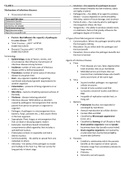Summary
Summary Understanding Pathophysiology, ISBN: 9781771721172 Pathophysiology (NURS1164)
- Course
- Pathophysiology (NURS1164)
- Institution
- Vancouver Community College (VCC )
This document describes the understanding pathophysiology textbook so students can ace their final exams.
[Show more]



